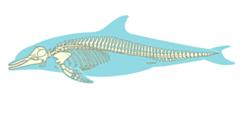Project 458: J. H. Geisler, M. R. McGowen, G. Yang, J. Gatesy. 2011. A supermatrix analysis of genomic, morphological, and paleontological data from crown Cetacea. BMC Evolutionary Biology. 11 (112):1-33.
Abstract
BackgroundCetacea (dolphins, porpoises, and whales) is a clade of aquatic species that includes the most massive, deepest diving, and largest brained mammals. Understanding the temporal pattern of diversification in the group as well as the evolution of cetacean anatomy and behavior requires a robust and well-resolved phylogenetic hypothesis. Although a large body of molecular data has accumulated over the past 20 years, DNA sequences of cetaceans have not been directly integrated with the rich, cetacean fossil record to reconcile discrepancies among molecular and morphological characters. Results
We combined new nuclear DNA sequences, including segments of six genes (~2800 basepairs) from the functionally extinct Yangtze River dolphin, with an expanded morphological matrix and published genomic data. Diverse analyses of these data resolved the relationships of 74 taxa that represent all extant families and 11 extinct families of Cetacea. The resulting supermatrix (61,155 characters) and its sub-partitions were analyzed using parsimony methods. Bayesian and maximum likelihood (ML) searches were conducted on the molecular partition, and a molecular scaffold obtained from these searches was used to constrain a parsimony search of the morphological partition. Based on analysis of the supermatrix and model-based analyses of the molecular partition, we found overwhelming support for 15 extant clades. When extinct taxa are included, we recovered trees that are significantly correlated with the fossil record. These trees were used to reconstruct the timing of cetacean diversification and the evolution of characters shared by "river dolphins," a non-monophyletic set of species according to all of our phylogenetic analyses.Conclusions
The parsimony analysis of the supermatrix and the analysis of morphology constrained to fit the ML/Bayesian molecular tree yielded broadly congruent phylogenetic hypotheses. In trees from both analyses, all Oligocene taxa included in our study fell outside crown Mysticeti and crown Odontoceti, suggesting that these two clades radiated in the late Oligocene or later, contra some recent molecular clock studies. Our trees also imply that many character states shared by river dolphins evolved in their oceanic ancestors, contradicting the hypothesis that these characters are convergent adaptations to fluvial habitats.
Read the article »
Project DOI: 10.7934/P458, http://dx.doi.org/10.7934/P458
| This project contains |
|---|
Download Project SDD File |
Currently Viewing:
MorphoBank Project 458
MorphoBank Project 458
- Creation Date:
20 January 2011 - Publication Date:
05 May 2011
This research
supported by
Authors' Institutions ![]()
- University of California Riverside
- Nanjing Normal University
- New York Institute of Technology
Members
| member name | taxa |
specimens |
media |
| Jonathan Geisler Project Administrator | 0 | 0 | 0 |
| MorphoBank Curator Full membership | 1 | 1 | 0 |
Project has no matrices defined.
Project downloads 
| type | number of downloads | Individual items downloaded (where applicable) |
| Total downloads from project | 488 | |
| Document downloads | 130 | Morph_part_tnt_matrix_order_b.tnt (31 downloads); Geisler_McGowen_Yang_Gatesy_matrix (62 downloads); Morphological_characters.pdf (25 downloads); Most parsimonious trees (11 downloads); Copyright information for exemplar media (1 download); |
| Project downloads | 358 |

